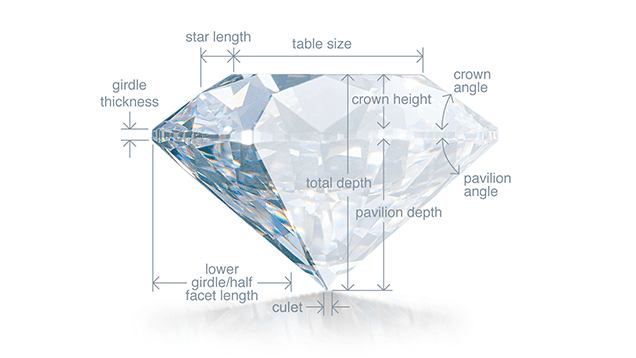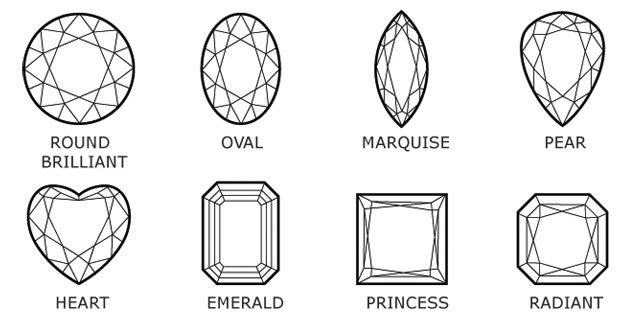Diamonds at Jack Miller Jewelry Designers
Here, at Jack Miller Jewelry Designers, we have a wide range of beautiful diamonds for you to choose from. When creating a custom design it is important to first decide what size and shape diamond you would like, then we build the ring around the stone (or stones) you choose. We are also happy to purchase your old diamond if you would like to upgrade to a bigger size or if you would like a different shaped diamond for a ring that you already own. Call us today to make an appointment to view our large selection of diamonds and to choose one for your gorgeous new ring. Call now for an appointment: 719-232-8122
Diamonds
Understanding the 4 C’s

Color
Diamond color is all about what you can’t see. Diamonds are valued by how closely they approach colorlessness – the less color, the higher their value. (The exception to this is fancy color diamonds, such as pinks and blues, which lie outside this color range.) Most diamonds found in jewelry stores run from colorless to near-colorless, with slight hints of yellow or brown.
(Source: http://www.gia.edu/gia-about-4Cs-Color)

Cut
Cut is the factor that fuels a diamond’s fire, sparkle and brilliance.
The traditional 58 facets in a round brilliant diamond, each precisely cut and defined, are as small as two millimeters in diameter. But without this precision, a diamond wouldn’t be nearly as beautiful. The allure of a particular diamond depends more on cut than anything else.
Though extremely difficult to analyze or quantify, the cut of any diamond has three attributes: brilliance (the total light reflected from a diamond), fire (the dispersion of light into the colors of the spectrum), and scintillation (the pattern of light and dark areas and the flashes of light, or sparkle, when a diamond is moved).
People often think of diamond cut as shape. Round is the shape used in most diamond jewelry. All other shapes are known as fancy shapes. Traditional fancy shapes include the marquise, pear, oval and rectangle. Hearts, triangles and a variety of others are also gaining popularity in diamond jewelry.
(Source: http://www.gia.edu/gia-about/4Cs-Cut)

Clarity
Because diamonds formed deep within the earth, under extreme heat and pressure, they often contain unique birthmarks, either internal (inclusions) or external (blemishes).
Diamond clarity refers to the absence of these inclusions and blemishes. Diamonds without these birthmarks are rare, and rarity affects a diamond’s value. Using the GIA International Diamond Grading System™, diamonds are assigned a clarity grade that ranges from flawless (FL) to diamonds with obvious inclusions (I3).
Every diamond is unique. None is absolutely perfect under 10× magnification, though some come close. Known as Flawless diamonds, these are exceptionally rare. Most jewelers have never even seen one.
(Source: http://www.gia.edu/gia-about/4Cs-Clarity)

Carat
Diamonds and other gemstones are weighed in metric carats: one carat is equal to 0.2 grams, about the same weight as a paperclip. (Don’t confuse carat with karat, as in “18K gold,” which refers to gold purity.)
Measure Diamonds By Carats
Just as a dollar is divided into 100 pennies, a carat is divided into 100 points. For example, a 50-point diamond weighs 0.50 carats. But two diamonds of equal weight can have very different values depending on the other members of the Four C’s: clarity, color and cut. The majority of diamonds used in fine jewelry weigh one carat or less.
Because even a fraction of a carat can make a considerable difference in cost, precision is crucial. In the diamond industry, weight is often measured to the hundred thousandths of a carat, and rounded to a hundredth of a carat. Diamond weights greater than one carat are expressed in carats and decimals. (For instance, a 1.08 ct. stone would be described as “one point oh eight carats,” or “one oh eight.”)
(Source: http://www.gia.edu/gia-about/4Cs-Carat)
Other Considerations
When Purchasing a Diamond
Shape

Cost
Cost is the unofficial fifth C. The primary four Cs all factor into the price of a diamond. The trick is finding that perfect balance of size, color, clarity and cut that fit into your budget. Working with Jack Miller, he can help find that balance, with his selection of diamonds, and sources of diamonds from around the country that he can bring in on memo, to give you your choice of options, allowing you to select which stone you want.
